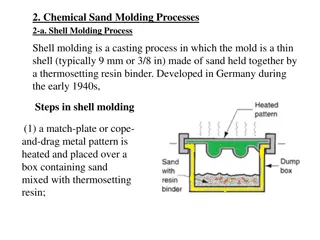Overview of Metal and Sand Casting Processes
Metal and sand casting are ancient manufacturing techniques dating back to 4000 B.C., allowing the production of complex shapes in various metals. The casting industry produces millions of kilograms of castings annually, primarily using materials like gray iron, ductile iron, aluminum alloys, and copper alloys. Casting offers advantages such as creating both internal and external shapes, isotropic material properties, and the ability to produce a wide range of part sizes. However, limitations include porosity, limited mechanical properties, and safety hazards due to molten metals. Different casting processes, such as expendable mold and permanent mold, offer varying levels of complexity and production rates. Careful product design considerations are essential for successful casting processes.
Download Presentation

Please find below an Image/Link to download the presentation.
The content on the website is provided AS IS for your information and personal use only. It may not be sold, licensed, or shared on other websites without obtaining consent from the author.If you encounter any issues during the download, it is possible that the publisher has removed the file from their server.
You are allowed to download the files provided on this website for personal or commercial use, subject to the condition that they are used lawfully. All files are the property of their respective owners.
The content on the website is provided AS IS for your information and personal use only. It may not be sold, licensed, or shared on other websites without obtaining consent from the author.
E N D
Presentation Transcript
Introduction to Metal and Sand Casting
Fundamentals of Casting Casting, one of the oldest manufacturing processes, dates back to 4000 B.C. when copper arrowheads ( ( were made. Casting processes basically involve the introduction of a molten metal into a mold cavity, where upon solidification, the metal takes on the shape of the mold cavity. Simple and complicated shapes can be made from any metal that can be melted. Casting sizes range form few mm (teeth of a zipper ) to 10 m (propellers of ocean liners (.
The Casting Industry 6.5 million kg of castings are produced every year The most common materials cast are gray iron, ductile iron, aluminum alloys, and copper alloys 35% of the market is in automotive and light truck manufacturing Castings are used in applications ranging from agriculture to railroad equipment, automobiles and aircrafts components, and heating and cooling equipments.
Capabilities and Advantages of Casting 1. 2. 3. 4. Can create complex part geometries Can create both external and internal shapes Some casting processes are net shape; others are near net shape Cast material is isotropic. It has the same physical and mechanical properties along any direction. It is economical, with very little wastage: the extra metal in each casting is re- melted and re-used Can produce a wide variety of sized parts: Large parts: engine blocks, cylinder heads, railway wheels, pipes etc. Small parts: dental crowns, jewelry, gears, brake components. 5. 6. Limitations of Casting 1. Porosity (empty spaces within the metal - reduces the strength of metal) 2. Limitations on mechanical properties 3. Poor dimensional accuracy and surface finish for some processes (sand casting) 4. Safety hazards to workers due to hot molten metals
Typical applications for castings and casting characteristics
Two Categories of Casting Processes 1. Expendable mold processes: uses a mold which is destroyed to remove casting: Mold materials: sand with binders, Foam and Wax. Advantage: more complex shapes possible Disadvantage: production rates often limited by time to make mold rather than casting itself 2. Permanent mold processes: uses a mold which can be used over and over: Made of metal (or ceramic refractory material) Advantage:higher production rates Disadvantage: geometries limited by need to open the mold
Product Design Considerations 1. Geometric simplicity - Avoid unnecessary complexity. 2. Corners - Avoid sharp corners (preferred fillet radius). 3. Section thickness - Uniform section thickness to avoid shrinkage cavities and hot spots. 4. Use of cores - minimize the use of core 5. Dimensional tolerance and surface finish - proper choice of casting method. 6. Inclination allowance (draft) - Facilitate removal of parts from mold in permanent casting, and for easy drag the pattern from the sand mold. 7. Machining allowance - For assembly purposes, typically 1.5 to 6 mm. 8. Shrinkage allowance For to compensating the shrinkage of the part.
Casting Processes 1. Preparing a mold cavity of the desired shape with proper allowances (inclination, shrinkage, and machining). Melting the metal with acceptable quality and temp. Pouring the metal into the cavity and providing means for the escape of air or gases. Solidification process, must be properly designed and controlled to avoid defects. Mold removal. Finishing, cleaning and inspection operations. Heat treatment of casting is sometimes required to improve metallurgical properties 2. 3. 4. 5. 6. 7. 9
Sand Casting Mold Terms Mold Mold frame (flask) consists of two parts Cope is the upper molding flask Drag is the lower molding flask Parting line separates the two halves Gating system Mold cavity Core if found
Advantageous of Sand Casting 1. Produce parts with complex geometries, both internally and externally. 2. Castings range in size from small to very large. 3. Nearly all alloys can be sand casted, including metals with high melting temperatures, such as steel, nickel, and titanium 4. Production quantities from one to millions 5. Inexpensive mold 6. Casting is the easiest and quickest way (technique) from drawing (design) to the production.
Disadvantageous of Sand Casting 1. Porosity strength of metal) 2. Limitation on mechanical properties 3. Poor dimensional accuracy 4. Poor surface finish 5. Safety hazards to humans and environmental problems 6. Slower production rate 7. Removal of pattern of the thin and small parts is very difficult (empty spaces within the metal - reduces the ) (























